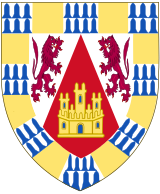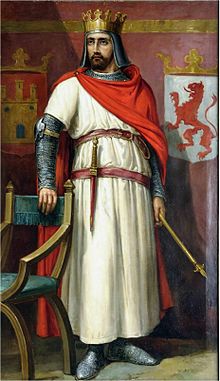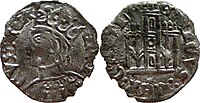Henry II of Castile
Enrique II of Castile, also known as Enrique de Trastámara, called “el Fratricida” or “el de las Mercedes” » (Seville, January 13, 1334-Santo Domingo de la Calzada, May 29, 1379), was King of Castile, the first of the House of Trastámara.
Biography
He was the third of the ten extramarital children of Alfonso XI and Leonor de Guzmán. The product of a twin pregnancy, he was the first of the couple's children to reach adulthood, as was his brother, whom he survived. Enrique and his twin brother Fadrique Alfonso de Castilla, were born in the Alcázar of Seville, although some authors place their birth in the Cabra castle, owned by their mother Leonor de Guzmán. Asturias inherited the following year, after his death, his lordship of the county of Noreña. His father later granted him the county of Trastámara and the lordships over Lemos and Sarria, in Galicia, and the towns of Cabrera and Ribera, which gave him a very large and important patrimony in the northwest of the Peninsula. He is the head of the new dynasty that arises from the main branch of the Burgundy-Ivrea dynasty, the Trastámara dynasty.
While Alfonso XI lived, his lover Eleanor obtained titles and privileges in exaggerated numbers for her children with the king. This was the cause of the discontent of numerous nobles, and above all of the legitimate queen, María de Portugal, and the infant heir, Pedro, better known as Pedro I the Cruel or the Justiciero. They had the opportunity for revenge when Alfonso XI died unexpectedly of plague in the siege of Gibraltar, in March 1350. They had not even buried the king and already many followers of Eleanor and her children turned them aside, and Enrique and his brothers they fled and scattered, fearful of the measures their half-brother, the new king, might take.
After the death of Alfonso XI
Although Leonor and her children reached an agreement with Pedro I to integrate peacefully into his court, the situation remained unstable. Enrique and his brothers Fadrique, Tello and Sancho staged numerous rebellions from the beginning of the reign. In addition, to strengthen his position and get allies, Enrique married Juana Manuel de Villena, daughter of Don Juan Manuel, adelantado mayor of Murcia and Lord of Villena, the most powerful nobleman of the previous reign. In 1351 the monarch (or his adviser Juan Alfonso de Alburquerque, a trusted man of María de Portugal), convinced that his father's lover was the instigator of the uprisings, ordered that Leonor be imprisoned and finally executed in Talavera de la Reina..
After this Enrique fled to Portugal. Pardoned by Pedro I and returned to Castile, he revolted in Asturias (1352). She reconciled with his brother only to rebel against him in a long and intermittent war that ended with the Count of Trastámara fleeing to France, where he entered the service of John II of France. Shortly after Enrique and his men became a soldier in the ranks of Pedro IV of Aragon, in the war that he maintained against Castile (1358). During this conflict he was defeated and imprisoned in Nájera (1360), but was released (with the help of Juan Ramírez de Arellano, among others) and went into exile in France.
When Aragon was attacked again, Enrique came to his aid, but in exchange for his support to dethrone his brother Pedro. The combined attack by Enrique and his Castilian, Aragonese and French allies (Bertrand Du Guesclin's mercenary companies) succeeded in expelling Pedro, who took refuge in Guyenne. Enrique was proclaimed king in Calahorra (1366), but in return he had to grant his allies titles and wealth without measure, as payment for the help received. This earned him the nickname el de las Mercedes.
Meanwhile, Pedro I organized an invasion of Castile from English dominions north of the Pyrenees. Edward, Prince of Wales (known as the Black Prince ), placed at his disposal a large army of knights and archers. Pedro I defeated Enrique in the battle of Nájera, fought on April 3, 1367. Enrique returned to France, protected by Carlos V. From the castle of Peyrepertuse he reorganized his armies and, aided by the rebels from numerous Castilian cities and by the Bertrand Du Guesclin's French mercenaries, the so-called White Companies, defeated Pedro in the battle of Montiel on March 14, 1369. Pedro I, already a prisoner, was assassinated at the hands of Enrique, who definitively ascended the throne of Castile with the name of Henry II.
Reign
Before seeing himself consolidated on his throne and being able to pass it on to his son Juan, Enrique had to defeat Fernando I of Portugal, whom he defeated in two of the so-called Fernandina Wars, and later Juan de Gante, 1st Duke of Lancaster, married to the Infanta Constanza de Castilla, daughter of Pedro I. In his conflict with the English of Edward III of England, Enrique II was an ally of Charles V of France, at whose disposal he placed the Castilian fleet, a fundamental piece in the siege of La Rochelle, in whose first phase, Admiral Ambrosio Bocanegra completely defeated the English squadron. In addition, the future admiral of Castilla Fernando Sánchez de Tovar plundered the entire coast of southern England.
Henry II rewarded his allies, alienating large tracts of royal territory, but he also knew how to defend the interests of the kingdom of León and Castilla. Thus, he denied the King of Aragon all the territorial cessions that he had promised him in difficult times. To pay the White Companies and the other mercenaries who had helped him, he adulterated the currency, a fact that made the rest of the kingdoms lose confidence in Castilian money.
In domestic policy, he began the reconstruction of the kingdom, protected the Jews after having persecuted them in the civil war, accelerated the transformation of the royal administration and convened numerous courts. Likewise, he definitively incorporated the lordship of Vizcaya into the royal patrimony after the death of his brother Tello de Castilla. In foreign policy, he was favorable to France against England.
Enrique II of Castile died on May 29, 1379 in Santo Domingo de la Calzada. He was succeeded on the Castilian throne by his son, Juan I of Castile.
Burial
After his death, the body of Enrique II of Castile was transferred to Burgos, then to Valladolid, and later to the city of Toledo, where it would be buried in the Chapel of the New Kings of the Toledo Cathedral, where His mortal remains rest today. The Jewish-converted poet from the Cancionero de Baena Pero Ferruz composed the same year of his death a long biographical poem in the first person that figures among his best works, the Dezir de Pero Ferruz al Rey Don Enrique (1379):
I never ceased wars / thirty years on. / I found people and lands / and won nobles ruled: / fiz ducats and counties / and very high lordships / and gave to strangers and mine / more than all my pasts / [...] Know that with my brothers / always I would want peace; / they walked me tyrants / looking for me astounded evil. / God, in whom yaz / the endeavor and might, / to exalt my lordship / and to them di mal solaz...
The king's sepulcher is placed on the choir stalls, on the Epistle side, and is an attached sepulcher in Plateresque style. The tomb box is adorned with the coat of arms of Castilla y León, and in the lower part of the interior of the burial lucillo there are three panels decorated with trophies, and on the three panels two children who appear holding the cartouche containing the epitaph of the monarch:
_
The recumbent statue of Henry II, made of polychrome alabaster, is placed on the tomb. The monarch, dressed in royal regalia, holds the sword and belt adorned with lions and castles in his left hand. In his right hand the monarch holds the sceptre, whose upper end rests on the three cushions that support the monarch's head. The king wears slippers and his feet rest on a lying lion.
The entrails of the monarch are entombed in the Cathedral of Santo Domingo de la Calzada.
Marriage and offspring
Enrique II married on July 27, 1350 with Juana Manuel de Villena, lady of Villena, Escalona and Peñafiel and daughter of the famous magnate and writer Don Juan Manuel and Blanca Núñez de Lara, with whom he had two sons and a daughter. daughter:
- John (1358-1390), successor of his father with the name Juan I.
- Leonor (1362-1415), married to Carlos III of Navarra
- Juana (1367-1374), died in childhood.
He had several children out of wedlock, some of whom he mentions in the will he made on May 29, 1374:
- Pedro Enríquez de Castilla (m. 1366), who died in childhood, was buried in the old cathedral of Segovia (after transferred to the present cathedral)
- Alfonso Enríquez (1355-c. 1400), son of Elvira Íñiguez, I count of Gijón and Noreña, lord of Cabrera and Ribera de Ribadesella, Villaviciosa, Nava, Laviana, Cudillero, Luarca and Pravia, the two Babias and the land of Argüellos.
- Constanza Enríquez de Castilla (c. 1360-?). His father doesn't mention his mother's name. He says that on that date, 1374, he was married to Infante Dionisio of Portugal, although he eventually married his brother, Infante Juan de Portugal. He inherited the village of Alba de Tormes, of which was I ma'am.
- Fadrique de Castilla (1360-1394), son of his relative Beatriz Ponce de León. Named by his father I duke of Benavente, he died in prison in Almodóvar del Río in 1394. She had a loving relationship with her cousin Leonor Sánchez de Castilla, illegitimate daughter of Sancho de Castilla, I count of Alburquerque, of whom she had a daughter.
- Leonor de Castilla la de los Leones, daughter of Leonor Álvarez. The mistress.
- Fernando Enríquez de Castilla (1365-1438). His father mentions it as the son of Beatriz Fernandez. He was master of half of Dueñas for donation of his sister Leonor of Castile the Lions. He lived in Portugal during the reign of Juan I, in whose house he had, in 1414, 27 000 pounds of Moorish of a gentleman. It was the I lord of the Alcaçovas in Portugal. He married in 1406 with Leonor Sarmiento, daughter of Diego Pérez Sarmiento, lord of Villamayor, and Mencía de Castro, and had Isabel Henriques, wife of Afonso Álvares Rangel, and Fernando Henriques, II lord of the Alcáçovas, husband of Branca de Melo, Mrs.Barbacena, with descent.
- Juana de Castilla (n. 1367), daughter of Elvira Íñiguez. His father mentions it in his will and says that if he did not enter into marriage with Pedro de Aragón, II Marquis de Villena (1362-Aljubarrota, 1385)—son of Alfonso de Aragón el Viejo—who inherited Urueña. Finally the marriage was celebrated in 1378 and were parents, among other children, of Leonor de Villena and of Enrique de Villena the Nigromantic, master of the Order of Calatrava, I count of Cangas and Tineo and III lord of Cifuentes, who married María de Albornoz, lady of the Infantado.
- Isabel Enríquez de Castilla (m. v. 1420), daughter of Juana de Cárcamo. He married Gonzalo Núñez de Guzmán, although marriage was dissolved by Pope Clement VII. He subsequently entered the convent of Santa Clara la Real in Toledo, in which he became abades and was buried.
- Inés Enríquez de Castilla (m. c. 1443), daughter of Juana de Cárcamo. Like her sister Elizabeth, she became a Abbot of the monastery of Santa Clara la Real in Toledo, where she was buried.
- Juana Enríquez de Castilla (c.1356-?), daughter of Juana, Mrs. He married the Infante Dionisio of Portugal, the son of Pedro I of Portugal and Inés de Castro, and was buried in the monastery of Guadalupe.
- Beatriz de Castilla (m. 1409), daughter of Beatriz Ponce de León, I mistress of Niebla, who married Juan Alonso Pérez de Guzmán in 1390, IV lord of Sanlúcar de Barrameda and I count of Niebla; later he professed as a religious in the monastery of San Clemente de Sevilla, where he was buried.
- María Enríquez de Castilla (1375-c. 1393), daughter of Beatriz Fernandez. He contracted marriage with Diego Hurtado de Mendoza, X lord of Mendoza, Admiral of Castile and eldest butler of King Juan II of Castile and was I ma'am of the royal villages of Cogolludo and Loranca de Tajuña, the villages of El Vado, Colmenar and El Cardoso in the current province of Guadalajara, and half of the Real of Manzanares.
- Enrique de Castilla o Enríquez (1377-1404) He was the son of the lady Cordoba Juana de Sousa and held the titles of I duke de Cabra and Medina Sidonia and lord of Morón, Alcalá de los Gazules, Portillo and Aranda de Duero. It was buried in the Mezquita-Cathedral of Córdoba.
Titles
At the end of his reign he held the titles of King of Castile, Toledo, León, Galicia, Seville, Córdoba, Murcia, Jaén, the Algarve and Lord of Molina.
| Predecessor: Pedro I | King of Castile 1366-1367 | Successor: Pedro I |
| Predecessor: Pedro I | King of Castile 1367-1379 Disputed (1367-1369) with Pedro I de Castilla | Successor: Juan I |
Ancestors
| Ancestors of Enrique II de Castilla | ||||||||||||||||||||||||||||||||||||||||||||||||||||||||||||||||||||||||||||||||||||||||||||||||||||||||||||||||||||||||||||||||||||||||||||||||||||||||||||||||||||||||||||||||||||||||||||||||||||||||||||||||||||||||||||||||||||||||||||||||||||||||||||||||||||||||||||||||||||||||||||||||||||||||||||||||||||||||||||||||||||||||||||||||||||||||||||||||||||||||||||||||||||||||||||||||||||||||||||||||||||||||||||||||||||||||||||||||||||||||||||||||||||||||||||||||||||||||||||||||||||||||||||||||||||||||||||||||||
|---|---|---|---|---|---|---|---|---|---|---|---|---|---|---|---|---|---|---|---|---|---|---|---|---|---|---|---|---|---|---|---|---|---|---|---|---|---|---|---|---|---|---|---|---|---|---|---|---|---|---|---|---|---|---|---|---|---|---|---|---|---|---|---|---|---|---|---|---|---|---|---|---|---|---|---|---|---|---|---|---|---|---|---|---|---|---|---|---|---|---|---|---|---|---|---|---|---|---|---|---|---|---|---|---|---|---|---|---|---|---|---|---|---|---|---|---|---|---|---|---|---|---|---|---|---|---|---|---|---|---|---|---|---|---|---|---|---|---|---|---|---|---|---|---|---|---|---|---|---|---|---|---|---|---|---|---|---|---|---|---|---|---|---|---|---|---|---|---|---|---|---|---|---|---|---|---|---|---|---|---|---|---|---|---|---|---|---|---|---|---|---|---|---|---|---|---|---|---|---|---|---|---|---|---|---|---|---|---|---|---|---|---|---|---|---|---|---|---|---|---|---|---|---|---|---|---|---|---|---|---|---|---|---|---|---|---|---|---|---|---|---|---|---|---|---|---|---|---|---|---|---|---|---|---|---|---|---|---|---|---|---|---|---|---|---|---|---|---|---|---|---|---|---|---|---|---|---|---|---|---|---|---|---|---|---|---|---|---|---|---|---|---|---|---|---|---|---|---|---|---|---|---|---|---|---|---|---|---|---|---|---|---|---|---|---|---|---|---|---|---|---|---|---|---|---|---|---|---|---|---|---|---|---|---|---|---|---|---|---|---|---|---|---|---|---|---|---|---|---|---|---|---|---|---|---|---|---|---|---|---|---|---|---|---|---|---|---|---|---|---|---|---|---|---|---|---|---|---|---|---|---|---|---|---|---|---|---|---|---|---|---|---|---|---|---|---|---|---|---|---|---|---|---|---|---|---|---|---|---|---|---|---|---|---|---|---|---|---|---|---|---|---|---|---|---|---|---|---|---|---|---|---|---|---|---|---|---|---|---|---|---|---|---|---|---|---|---|---|---|---|---|---|---|---|---|---|---|---|---|---|---|---|---|---|---|---|---|---|---|---|---|---|---|---|---|---|---|---|---|---|---|---|---|---|---|---|---|---|---|---|---|---|---|---|---|---|---|---|---|---|---|---|---|---|---|---|---|---|---|---|---|---|---|---|
| ||||||||||||||||||||||||||||||||||||||||||||||||||||||||||||||||||||||||||||||||||||||||||||||||||||||||||||||||||||||||||||||||||||||||||||||||||||||||||||||||||||||||||||||||||||||||||||||||||||||||||||||||||||||||||||||||||||||||||||||||||||||||||||||||||||||||||||||||||||||||||||||||||||||||||||||||||||||||||||||||||||||||||||||||||||||||||||||||||||||||||||||||||||||||||||||||||||||||||||||||||||||||||||||||||||||||||||||||||||||||||||||||||||||||||||||||||||||||||||||||||||||||||||||||||||||||||||||||||



